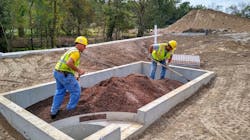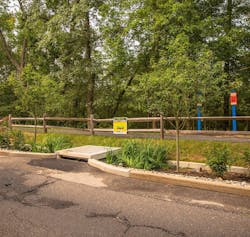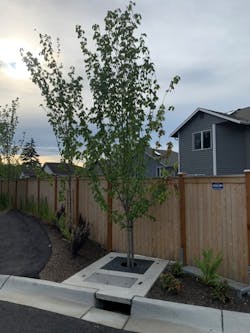Helping Communities Mitigate Risks from Extreme Weather
Across the globe, extreme weather conditions are on the rise, causing drought and flooding events. According to the Environmental Protection Agency, a larger percentage of precipitation is occurring during intense single-day events, causing soil erosion, flood risk and impairing water quality from land pollutants washing into bodies of water.
Some communities have reduced stormwater runoff through innovative green infrastructure (GI) plans. Flooding and drought effects are felt everywhere, but in highly urbanized areas where space is scarce, green infrastructure with a reduced footprint that can handle a high volume of water is often a necessity.
Some communities have benefited from Oldcastle Infrastructure’s signature products — TerraMod™ modular bioretention system and BioPod™ biofiltration system — to address stormwater runoff. As part of an effective GI plan, these products can help reduce flooding, address water supply concerns by promoting infiltration to improve groundwater reserves and reduce water pollution.
Two community projects highlight the impact these products can have: The replacement of outdated stormwater infrastructure that discharged untreated runoff directly into a lake in Lake Carasaljo Park in Lakewood, N.J.; and the transformation of an abandoned residential neighborhood into a commercial district in College Park, Ga.
Lakewood, N.J.
Lake Carasaljo Park in Lakewood, N.J., is in a highly developed residential area. The 74-acre lake, surrounded by development and walking trails, is a heavily used recreational area. Outdated stormwater infrastructure discharged untreated runoff directly into the lake, affecting the water quality in the watershed.
Colliers Engineering & Design, a multi-discipline engineering, design and consulting firm, found a viable green solution to address these issues with a smaller footprint than traditional bioretention.
Colliers designers specified the TerraMod modular bioretention system, manufactured by Oldcastle Infrastructure, at two of the identified locations for retrofit stormwater mitigation. The TerraMod system fit into narrow grass strips between the existing curb and walking paths around the lake. The system provided a high flow treatment of runoff before being discharged into the lake and infiltrated into the soil. The precast vault offered structural support that protected the surrounding hardscape and eliminated the need for wide excavations.
“The project was a huge success. There’s a highly traveled roadway and pedestrian sidewalk next to the installation and we were able to install and open it back up to traffic within a matter of days,” said Yosef Portnoy, senior project manager at Colliers Engineering & Design. “We have these bioretention systems improving water quality, groundwater recharge and reducing runoff to the lake. And they’re attractive, highly visible projects.”
The result was a significant reduction in pollutants discharged to the lake. After installation of green infrastructure solutions, there was a 63 percent reduction in nitrogen and 80 percent reduction in phosphorus, as well as reductions in other pollutants. By allowing stormwater to infiltrate into the soil, the TerraMod systems enhance groundwater recharge and decrease runoff.
More communities are turning to environmentally friendly solutions to manage stormwater. Like the successful project at Lake Carasaljo illustrates, green infrastructure provides a host of environmental benefits.
As municipalities across the country deal with stormwater issues, regulations are continuing to go into effect for both public and private developments. Many premanufactured stormwater treatment systems fit into these new regulatory guidelines with primary goals of treatment and volume reduction.
Smaller-scale green infrastructure uses decentralized Best Management Practices (BMPs), which spread green infrastructure over the site to treat water closer to its source. Distribution of BMPs may allow for more intensive development of a site, as there is more than one dedicated area for water treatment, infiltration or storage. And like the TerraMod system, precast modular bioretention planter boxes are easily installed in a few days and are a necessity in highly trafficked developments.
Before the retrofit at Lake Carasaljo Park, the untreated outfalls to the lake allowed larger debris to pass through. The TerraMod systems installed at Lake Carasaljo Park were fitted with a prefilter module to trap larger debris at an existing inlet before the water moved into the system. One purpose of pretreatment is to concentrate pollutants in one area and to preserve the life of the treatment system, making maintenance easy and efficient. The soil at Lake Carasaljo had good permeability rates but, due to proximity to the lake, seasonal high waters and high groundwater, the TerraMod system also included an underdrain to collect and discharge treated runoff that could not be infiltrated. The underdrain included sample ports to facilitate testing at the installation.
Green infrastructure is cost effective but can be challenging due to its requirement for large areas for implementation. Using compact, low-impact green infrastructure systems for stormwater management that fit into small, unusable spaces traditionally used for landscaping can help mitigate development limitations.
College Park, Ga.
Located on the southern edge of metro Atlanta near the world’s busiest airport, College Park, Ga. sought to redevelop an abandoned residential neighborhood into a viable commercial district. Yet it also needed to address flooding concerns, caused by the complete lack of a stormwater drainage system.
College Park’s leaders proposed a low-impact development green solution for stormwater and irrigation management. With only 10 percent of land allocated for green space, the city needed a compact solution that could handle not only the existing streets but also future build-outs in the district.
Oldcastle’s BioPod system was identified as an environmentally friendly and aesthetically pleasing option that met the Georgia Stormwater Management Manual requirement for 80 percent removal of total suspended solids (TSS). The city installed more than 100 BioPod units. The system integrated seamlessly into standard site drainage spaces where water was collected at curb cuts or curb inlets.
BioPod uses a proprietary high-flow rate StormMix™ media that allows for treatment of a large area removing not only suspended solids but also petrochemicals and other pollutants. Each BioPod contains an 18-inch layer of StormMix media topped with 2 inches of shredded mulch. The biofilter provides a treated flow capacity of 0.115 CFS for a 4-foot by 8-foot unit. Each unit has a perforated underdrain to carry treated runoff out into the regional drainage system. Maintenance of the unit consists mainly of debris removal and periodic replacement of the mulch layer.
The green solution fit into the available space, provided stormwater management, and housed regionally appropriate trees to help the city get much-needed funding for the project.
“Without the BioPods, the project never would have been approved,” said College Park City Engineer Jackson Myers.
Against a backdrop of more extreme weather and flooding, communities like College Park and Lakewood are solving problems with innovative green infrastructure solutions. GI installments, like Oldcastle’s BioPod and TerraMod systems, help address increasingly prescriptive regulations, which tighten designers’ options for green infrastructure. SW
About the Authors: Jay Holtz is currently the director of regulatory management at Oldcastle Infrastructure. Having earned his degree in Civil Engineering in 1986, Holtz’s career with stormwater treatment systems spans more than 30 years.
Mark Sweeney is Oldcastle’s product manager for stormwater green infrastructure, where he oversees both product development and strategic marketing for the company’s BioPod and TerraMod products.
Published in Stormwater magazine, November 2021.
Jay Holtz
Jay Holtz is currently the director of regulatory management at Oldcastle Infrastructure. Having earned his degree in Civil Engineering in 1986, Holtz’s career with stormwater treatment systems spans more than 30 years.
Mark Sweeney
Mark Sweeney is Oldcastle’s product manager for stormwater green infrastructure, where he oversees both product development and strategic marketing for the company’s BioPod and TerraMod products.








